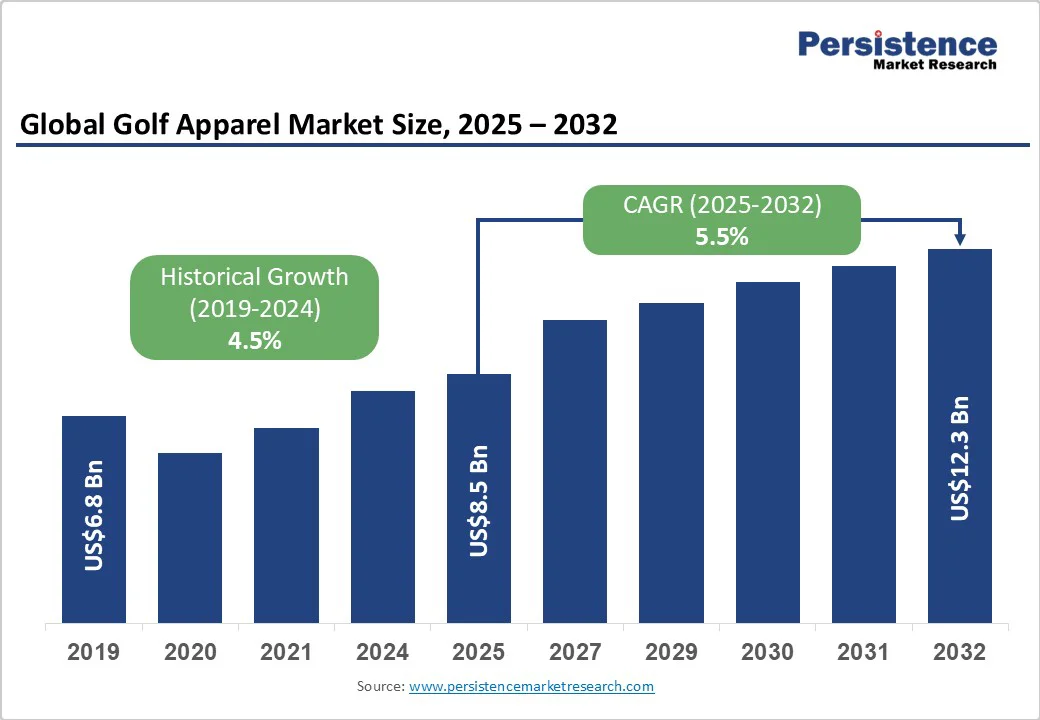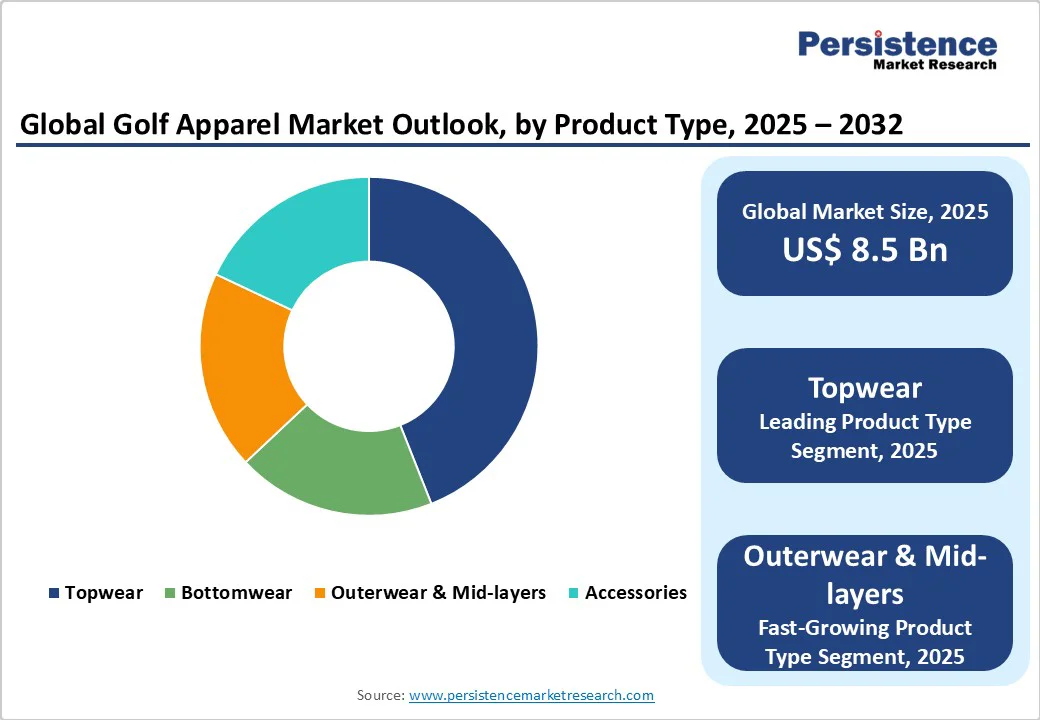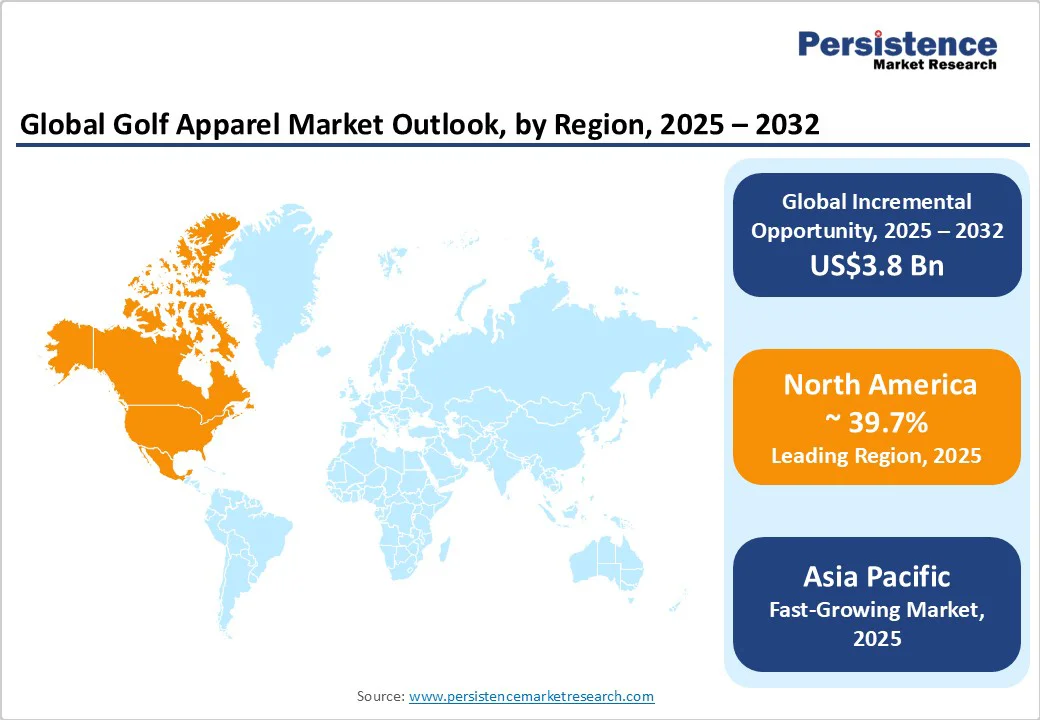ID: PMRREP35728| 210 Pages | 14 Oct 2025 | Format: PDF, Excel, PPT* | Consumer Goods

The global golf apparel market size is expected to be valued at US$8.5 billion in 2025. It is expected to reach US$12.3 billion by 2032, growing at a CAGR of approximately 5.5% during the forecast period from 2025 to 2032, driven by the rising number of golf participants across all demographics, the evolution of performance-oriented and sustainable fabrics, and the rapid expansion of omnichannel retail networks.
| Key Insights | Details |
|---|---|
|
Golf Apparel Market Size (2025E) |
US$8.5 Bn |
|
Market Value Forecast (2032F) |
US$12.3 Bn |
|
Projected Growth (CAGR 2025 to 2032) |
5.5% |
|
Historical Market Growth (CAGR 2019 to 2024) |
4.5% |

Global golf participation has expanded significantly over the past few years, with the sport attracting a younger and more diverse audience. In the U.S. alone, participation has surpassed 28 million on-course players, with women now accounting for nearly 28% of the total. This surge is mirrored in Europe and Asia, where golf is being integrated into tourism and community recreation. The growing base of new players, combined with fashion-conscious millennials, has broadened the customer pool for golf apparel. The direct impact is a sustained increase in per-player spending on technical and lifestyle golfwear.
Continuous advances in fabric science are transforming the market. The introduction of moisture-wicking materials, UV-resistant coatings, four-way stretch textiles, and thermoregulation technologies is redefining comfort and performance. These innovations not only enhance player experience but also extend apparel durability, justifying higher price points. The expansion of smart textiles, incorporating cooling microfibers and antibacterial treatments, further supports the premiumization of golfwear. Brands that integrate such innovations are capturing a larger share of premium consumers, driving higher average selling prices (ASPs) across product lines.
Golf apparel brands are increasingly utilizing digital platforms to connect directly with consumers. The post-pandemic shift toward e-commerce has encouraged leading brands to enhance online personalization tools, virtual fitting solutions, and subscription-based models. Direct-to-consumer channels offer greater margin control and faster feedback loops, while omnichannel strategies integrate club shops, specialty stores, and digital experiences to provide a seamless customer experience. As a result, digital sales are growing at nearly twice the pace of traditional retail, significantly improving profitability and inventory efficiency for key players.
Market estimates for golf apparel vary significantly across research sources due to differences in defining product scope, inclusion of accessories, and treatment of wholesale club sales. This inconsistency can create confusion for investors and retailers attempting to benchmark performance. The absence of a unified global classification standard increases the risk of under- or over-valuing segments, thereby complicating supply chain planning and investment decisions.
The volatility of raw materials, such as polyester, spandex, and recycled fibers, continues to impact production costs. Shipping disruptions and elevated energy prices have further increased expenses for global apparel manufacturers. As consumer price sensitivity rises in mid-tier markets, brands face limited flexibility in transferring these costs to end users, resulting in potential margin compression. Companies must focus on efficient sourcing, nearshoring, and supply chain digitalization to mitigate these cost pressures.
The most promising growth avenue lies in women’s and junior golf apparel. Female participation in golf has reached record levels in both established and emerging markets. Brands that tailor collections to fit female preferences, offering performance fabrics with modern aesthetics, are tapping into an underserved demographic. Women’s collections alone could contribute up to 15% incremental revenue growth in mature golf economies over the next five years.
Asia Pacific is expected to outpace global market growth, supported by surging golf participation in China, Japan, South Korea, and India. The region benefits from a strong manufacturing base, enabling cost-efficient production and faster product turnaround. Government investments in golf tourism and the development of high-end resorts in Thailand, Indonesia, and Vietnam further stimulate demand for apparel. The region is projected to grow at least one to two percentage points faster than the global CAGR during 2025–2032.
Consumers are increasingly willing to pay a premium for environmentally responsible apparel. Golf brands are introducing collections made from organic cotton, recycled polyester, and biodegradable packaging, aligning with corporate sustainability goals. Transparent supply chains, verified certifications, and eco-friendly dyeing techniques are becoming differentiators. Sustainable product lines not only appeal to eco-conscious consumers but also prepare brands for future environmental compliance regulations in Europe and North America.
Topwear, comprising polo shirts, t-shirts, base layers, and lightweight jackets, is anticipated to lead the market with a 48% market share in 2025. This category remains essential to player wardrobes due to its versatility, visibility, and frequent replacement cycle. Polo shirts, in particular, dominate sales due to their comfort, UV protection, and club-appropriate design. Leading brands such as Nike Golf, Adidas, FootJoy, and Under Armor refresh their topwear lines frequently, integrating fabric technologies such as Dri-FIT, Climacool, and SensorCool to enhance moisture management and flexibility. Limited-edition collections tied to professional tournaments, seasonal color updates, and athlete endorsements, such as Nike’s Rory McIlroy Signature Polo and Adidas’ Ultimate365 line, further fuel demand, particularly in North America and Europe.
Outerwear and mid-layers, including rainwear, thermal jackets, windbreakers, and vests, form the fastest-growing segment. This growth is driven by innovations in performance materials and an expanding population of year-round golfers. Advanced garments now feature waterproof yet breathable membranes, stretch fabrics, and thermal insulation.
Brands such as Galvin Green, Sun Mountain, and Under Armour lead with technologies, including GORE-TEX and PrimaLoft. Products such as Galvin Green’s Interface-1 jackets and FootJoy’s HydroLite series have gained traction in temperate, rain-prone markets, including the U.K., Japan, and the northern U.S., where functionality and weather resistance are key.
Men currently hold the largest revenue share, 59% in 2025, driven by historically higher participation rates and entrenched purchasing behaviors. The visibility of men in professional circuits, private clubs, and corporate golf settings reinforces this dominance. Technical performance, varied fits, and strong brand loyalty are hallmarks of men’s golf apparel. Players often curate wardrobes across top brands such as FootJoy, Nike, Adidas, Puma Golf, and Callaway. Performance polos and trousers remain key sales drivers, offering UV protection, moisture-wicking capabilities, and stretch for optimal movement. Endorsements by elite players such as Tiger Woods (Nike), Justin Thomas (FootJoy), and Jon Rahm (Callaway) enhance brand appeal and support premium pricing strategies.
Women’s golf apparel represents the fastest-growing segment, attracting investments from brands such as Lululemon, J.Lindeberg, Adidas, and PUMA Golf. These companies are launching women-specific collections with tailored fits, lightweight stretch fabrics, and versatile styling designed to transition from course to casual settings. Lululemon’s “Swing Series” and Adidas’ “Go-To Collection” exemplify this shift, featuring soft hues and functional silhouettes that resonate with younger consumers. Increased visibility of the LPGA Tour and collaborations with players such as Nelly Korda have elevated the category’s style profile. Social media, influencer campaigns, and women-focused golf events continue to boost online and in-store demand.

North America is expected to dominate, accounting for over 39.7% of the revenue share in 2025, with the U.S. as the leading contributor. This leadership is fueled by a deeply rooted golf culture, a vast network of over 16,000 golf courses, and strong spending habits among active golfers. According to the National Golf Foundation, on-course participation in the U.S. reached 27.9 million in 2024, while off-course formats, such as Topgolf and simulator golf, attracted over 30 million additional participants. This dual-channel engagement drives demand for both functional and lifestyle golf apparel across physical and digital retail platforms.
The region benefits from a mature retail ecosystem, including major outlets such as PGA Tour Superstore, Dick’s Sporting Goods, and Golf Galaxy, alongside brand-owned and online stores. Consumer preferences are shifting toward products that prioritize performance and sustainability. Nike Golf’s “Victory Tour Recycled Collection,” launched in April 2025, exemplifies this trend, featuring apparel made from 90% recycled polyester.
North America also leads in fabric innovation. U.S.-based brands such as Under Armour and FootJoy are at the forefront of moisture-wicking and stretch material technologies. Under Armour’s February 2024 expansion of its “Iso-Chill Golf Series” introduced cooling fabric innovations tailored to hot-weather play, reinforcing the region’s market leadership.
Asia Pacific is the fastest-growing regional market for golf apparel, driven by urbanization, rising incomes, and growing female participation. Countries, including China, Japan, South Korea, Thailand, and India, are witnessing unprecedented growth in golf course development and retail consumption. According to the Asian Golf Industry Federation (AGIF), golf participation in Asia rose by over 20% between 2020 and 2024, with China and South Korea leading the surge. Japan, the region’s most mature market, features a discerning consumer base that values both performance and fashion, with premium brands such as DESCENTE, PEARLY GATES, and Mizuno dominating.
Recent strategic investments highlight the region’s importance. In June 2024, PUMA Golf launched a design center in Tokyo to tailor collections to Asian body types and cultural preferences. Fila Holdings partnered with Hyundai Department Stores in 2025 to introduce co-branded golfwear lines focused on e-commerce.
Lululemon and Under Armour are also expanding digital operations in Japan and China to tap into rising online demand for luxury sportswear. The growing influence of celebrity golfers such as Hideki Matsuyama and Atthaya Thitikul, along with social media, is reshaping golf as a lifestyle trend, particularly among younger consumers across the Asia Pacific.
Europe's golf apparel market is mature yet steadily growing, driven by strong participation in countries such as the U.K., Germany, France, and Spain. With over 7 million active golfers, according to the European Golf Association (EGA), golf ranks among the top leisure sports in Western Europe. A key market trend is the fusion of golf fashion with everyday leisurewear, as consumers increasingly seek performance-oriented yet stylish apparel. Brands such as J.Lindeberg, Lacoste, and Puma Golf cater to these preferences through tailored fits, premium materials, and refined European aesthetics.
Sustainability is becoming central to the market’s evolution. The EU’s Green Deal and Textile Strategy (2023–2030) are encouraging brands to adopt eco-conscious practices. In response, Adidas Europe committed to using 100% recycled polyester and BCI cotton by 2026, while J. Lindeberg’s 2025 “Tour Tech Collection” emphasized UV protection and sustainable production. These shifts reflect a broader shift toward ethical, high-performance golf wear in the region.

The global golf apparel market exhibits moderate concentration at the top, led by multinational sportswear corporations and established golf specialists. Leading players command strong brand recognition and distribution networks, particularly in premium and performance categories. However, the market remains fragmented at the mid-tier level, where lifestyle and boutique golfwear brands compete through design innovation and niche marketing. The coexistence of global giants and regional brands creates a balanced but highly competitive environment.
Leading companies emphasize innovation, premiumization, sustainability, and digital transformation. Continuous R&D in material science, celebrity endorsements, and integration of golf fashion into everyday wear are core strategic themes. Market leaders are also adopting flexible manufacturing and regional customization to enhance responsiveness to shifting consumer trends.
The golf apparel market size is estimated at US$8.5 Billion in 2025.
The market is projected to reach US$12.3 Billion by 2032, growing steadily across all regions.
Key trends include the growth of outerwear and mid-layer apparel with advanced weather protection fabrics and increasing women’s participation, driving tailored and athleisure-inspired collections.
Topwear (polos, t-shirts, light jackets) is the leading segment, accounting for over 48% of global product revenue, due to its cross-functional use and frequent replacement cycle.
The golf apparel market is projected to grow at a CAGR of 5.5% from 2025 to 2032.
Major players include Nike Golf, Adidas Golf, FootJoy, Under Armour, and PUMA Golf.
| Report Attribute | Details |
|---|---|
|
Historical Data/Actuals |
2019 - 2024 |
|
Forecast Period |
2025 - 2032 |
|
Market Analysis |
Value: US$ Bn |
|
Geographical Coverage |
|
|
Segmental Coverage |
|
|
Competitive Analysis |
|
|
Report Highlights |
|
By Product Type
By End-user
By Distribution Channel
By Region
Delivery Timelines
For more information on this report and its delivery timelines please get in touch with our sales team.
About Author